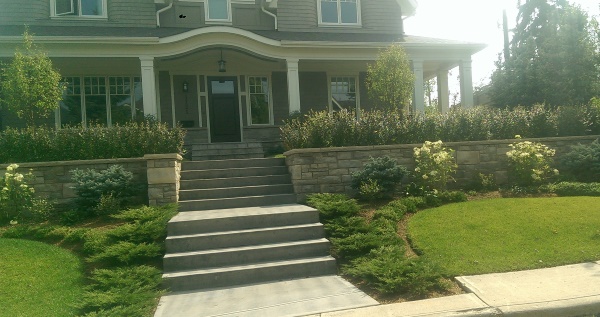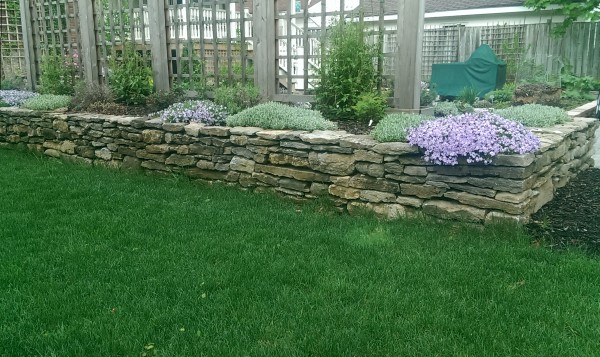Landscaping outdoor rooms
The landscaping concept of outdoor rooms is the next section in our landscape design series. I have always loved this concept as it is a great way for homeowners to have a better understanding of do-it-yourself landscape design. Many people can design inside their own home but are lost when it comes to the outside, but the two aren't as different as you might think.
I'm pretty sure I was a teenager in school the first time I heard the term KISS. (Keep it simple stupid). I don't use it with other people, because I dislike the word “Stupid”, but it sticks once you learn it kind of like the “Assume” one I'm sure we all know.
So how do you keep it simple when you have so many ideas and your yard only has so much space to work with. We've been talking about different “Features” in your yard. Patios, paths, waterfalls, ponds, fountains, garden beds, walls and playground areas for kids are all examples of features. Your wish list may actually have more than the space you have available to accommodate it.
It's important to know the more
features you add, the more difficult landscaping planning becomes and
the more overcrowded your design will be. We don't just mean
physically overcrowded either. You need to know where to put these
features to avoid an overcrowded and awkward looking yard.
Landscaping outdoor rooms
Landscape designing involves the concept of “Outdoor Rooms”. Your outdoor space can be compared to the inside of your home in many ways. There are 4 basic categories that each have multiple purposes. The public area, the family area, the service area, and the private area. You will more than likely only have to consider 3 of these.
The public area is your front yard, or area that should lead to the front door. It is public because everyone can see it driving or walking by. The family area makes up the majority of your backyard and side yard and would be more “Semi” private. It usually contains things like a patio, lawn, pool, or kids area. It would be similar to the inside of your house having a living room, games room, TV room, etc...
The service area is usually out of view of the family area and contains things like sheds, tools, garbage cans, recycle bins etc... Try to avoid having things like this in the family area if they really belong in the service area. With today's smaller yards the service area is often tucked down the side of the house.
Very few homes would have a private area these days. A sundeck off a bedroom that would be almost completely screened from view would be a good example of a private area.
The moment you start running out of room to put anything in your design is when you should really think about overcrowding. Ask yourself, Do you have room for it? Is it necessary? KISS
So now you can see that landscaping outdoor rooms is a little bit like designing the inside of your home. Here's something else to consider from the inside of your house looking out.
Framing a view
Don't forget that you can also frame a view. It may be from
looking out the kitchen window, or maybe the view from your favorite
chair in the living room. What would you like to see? A garden bed?
The waterfall or pond? Walk around the inside of your house looking
out each window and decide if there is a certain view you would like
to frame and incorporate a feature in your design for it.
Floors, walls and ceilings
Did you know that just like your house, your yard will also have floors, walls and ceilings? The walls are usually vertical elements to help you to separate the outdoor rooms. They can also allow you to control or restrict movement throughout your yard. A great example of this would be a hedge along a walkway, a series of strategically planted shrub, or a garden bed. Just remember that an outdoor wall should be placed where it makes logical sense.
The outdoor floors are simple. Grass, bricks, flagstone, gravel, or anything else underneath your feet. These should also make sense as you transition between rooms in your yard. One other thing to think about is like a house, each room in the house that is entirely separated from other rooms can have its own identity. We mentioned this in part 2 of the series when we talked about landscaping themes. If there is only a partial separation and the eye can visually see two rooms simultaneously, the eye can get confused. For example, a combined living room and dining room must have some form of unity in the way they are decorated.
Lastly would be the outdoor ceiling. This could be a pergola, awning, or even a shade providing tree. They can define the upper limits of your yard. Now you know a little more about the concept of landscaping outdoor rooms and you are gaining some better insight into DIY landscape designing.
In the next installment of the series we are going to focus on the front yard, and curb appeal, but here are a few things to remember with outdoor rooms.
Avoid clutter by having only what your space will accommodate.
Understand the concept of outdoor rooms and keep features in the room where they make the most sense.
Keep things as simple as you can.
Define the outdoor rooms using walls, floors, and ceilings tastefully.
Return to Dream Yard Home page
Part 1. DIY landscape design introduction
Part 2. DIY landscape design themes
Part 3. Landscape design planning
Part 4. Landscaping outdoor rooms
Part 5. Front yard landscape design
Part 6. Principles of landscape design
Check out our time and money saving e-book
How to avoid the biggest mistakes made by DIYers, designers, and landscaping companies.
Visitor
Favorites
Giggles 'n' Thoughts







